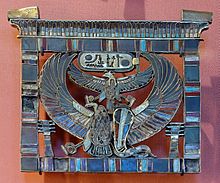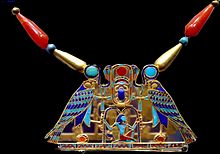Calasiris
Elements of Egyptian clothing


In ancient Egypt, linen was a common textile as it helped people to be comfortable in the subtropical heat. Plant dyes could be applied to clothing but the clothing was usually left in its natural color. Wool was known, but considered impure. Only the wealthy wore animal fibers that were the object of taboos. They were used on occasion for overcoats, but were forbidden in temples and sanctuaries.
Peasants, workers and other people of modest condition often wore nothing, but the shenti (made of flax) was worn by all people. Slaves often worked naked.
Unique headdresses included the khat and nemes.
Deities
There were several ancient Egyptian deities related to fabrics, clothing and weaving, chiefly the god Hedjhotep and the goddess Tayt.
Pharaohs

Royal clothing is particularly well documented, as well as the khat, nemes, and crowns of the pharaohs. The pharaohs would often wear animal skins, usually leopard or lion, as a sign of their station.
Men
From about 2130 BC during the Old Kingdom, garments were simply constructed. Men wore wrap around skirts belted at the waist. This style of dress was consistent across class but higher class Egyptians wore more finely crafted pieces.
While women's clothing changed during the Middle Kingdom, men's clothing stayed largely static (as evidenced by available art). The two most notable changes were the pleating of the skirts and the adoption of the triangular apron by upper-class men. This starched ornamented kilt was held up by a sash and worn over a loincloth.

Artistic relics from the New Kingdom show the largest evolution in men's clothing. New Kingdom art depicts the use of sheer blouses with intricately pleated sleeves, as well as more elaborate pleating of the skirts with sheer overskirts. Still, only wealthier citizens could afford these materials
Women



During the Old, Middle and New Kingdom, ancient Egyptian women mostly wore a simple sheath dress called a kalasiris, which is shown to cover the breasts in statues, but in paintings and relief the single breast depicted in profile is exposed. Women's clothing in ancient Egypt was more conservative than men's clothing. The dresses were held up by one or two straps and were worn down to the ankle, while the upper edge could be worn above or below the breasts. The length of the dress denoted the social class of the wearer. Beading or feathers were also used as an embellishment on the dress. Over the dress, women had a choice of wearing shawls, capes, or robes. The shawl was a piece of fine linen cloth around 4 feet wide by 13 or 14 feet long, which was mostly worn pleated. Surviving dresses consist of a body made from a tube of material sewn up one side, supported not by straps but by a bodice with sleeves. In contrast to dresses shown in art, such linen garments tend to be baggy, and would conceal rather than reveal the body. It was made of linen, a material that tends to sag but is shown to hug the body with no slag.
Children
Children wore no clothing until 6 years old. Once they turned six they were allowed to wear clothing to protect them from the dry heat. A popular hairstyle among children was the side-lock, an unshaved length of hair on the right side of the head. Even though children usually wore no clothing, they wore jewelry such as anklets, bracelets, collars, and hair accessories.
Wigs


Wigs were worn by the wealthy of both sexes. Made from human hair and sometimes supplemented with date palm fiber, they were often styled in tight curls and narrow braids. For special occasions, both men and women could top their wigs with cones of perfumed fat that would melt to release their fragrance and condition the hair.
Jewelry

Jewelry was very popular in ancient Egypt, no matter the social class. It was heavy and rather voluminous. The main reason for wearing jewelry is because of its aesthetic function. The Egyptians were quite soberly dressed in white linen fabrics, and jewelry offered a possibility for contrast. The Egyptian preference was towards the use of bright colors, lustrous stones and precious metals. Gold was won in large quantities in the eastern desert of Egypt, but also came from Nubia, that was an Egyptian colony for centuries.
On the other hand, silver was rare and was imported from Asia. Therefore, it was silver that was often considered more precious than gold. The eastern desert was also an important source for colorful semi-precious stones such as carnelian, amethyst and jasper. In the Sinai were turquoise mines, the deep blue lapis lazuli had to come from far away Afghanistan. Glass and faience (glaze over a core of stone or sand) were favorites to replace rocks because they could be produced in many colors.
The Egyptians became very skilled when making jewelry from turquoise, metals like gold and silver, and small beads. Both men and women adorned themselves with earrings, bracelets, rings, necklaces and neck collars that were brightly colored. Those who could not afford jewelry made from gold or other stones would make their jewelry from colored pottery beads.
One creation that was specific to ancient Egypt was the gorgerine, an assembly of metal discs worn on the chest, either over bare skin or over a shirt, and attached in the back.


Cosmetics
Embalming allowed the development of cosmetics and perfumes. The perfumes of Egypt were the most numerous, but also the most sought and the costliest of antiquity, which used them extensively. The Egyptians used makeup most of all the ancient people. Nails and hands were painted with henna.
Black kohl, which was used to mark eyes, was obtained from galena. Eye shadow was made from crushed malachite. Red, which was applied to lips, came from ochre. These products were mixed with animal fat to make them compact and to preserve them. Both men and women wore galena or malachite eyeliner to protect the eyes and enhance their beauty.
Findings were published by American Chemical Society in the journal Analytic Chemistry suggest that the use of lead in makeup was intentional. Findings suggest that the lead in combination with salts produced naturally by the body produce nitric oxide which boosts the immune system. It is believed that the production and result were intentional. The increase in immune productivity would help to prevent infections like conjunctivitis.
Footwear
Footwear was the same for both sexes. It consisted of coiled sewn sandals of leatherwork, or for the priestly class, papyrus. Since Egyptians were usually barefoot, sandals were worn on special occasions or at times when their feet might get hurt.
New Kingdom of Egypt
Women's fashions of this period were more elaborate than in any previous era. Both men and women in Egypt often shaved their heads to prevent lice and to reduce the time it took to maintain a full head of hair. Wigs were worn by both sexes to protect the scalp and for ceremonial purposes.
See also
References
- ^ "Ancient Egyptian Clothing". Archaeology Now. Retrieved 2025-01-04.
- ^ "Clothes in Ancient Egypt: The Real History". Amr Saleh. Retrieved 2025-01-04.
- ^ "Ancient Egyptian costumes".
- ^ Zecchi, Marco (2001). "The god Hedjhotep". Chronique d'Égypte. LXXVI (151–152): 5–19. doi:10.1484/J.CDE.2.309159.
- ^ Black, J. Anderson (1980). A History of Fashion. New York: Morrow. ISBN 0688058353.
- ^ Pendergast, Sara (2003–2004). Fashion, Costume, and Culture: Clothing, Headwear, Body Decorations, and Footwear Through the ages. Detroit: UXL. ISBN 0787654175.
- ^ Strudwick, Helen (2006). Encyclopedia of Ancient Egypt. London: Sterling Publishing. ISBN 1782744363.
- ^ "Length of Very Sheer Linen Cloth". www.metmuseum.org. The Metropolitan Museum of Art. Retrieved 5 May 2021.
- ^ Tierney, Tom (1999). Ancient Egyptian fashions. Mineola, N.Y.: Dover. p. 2. ISBN 9780486408064.
- ^ Tierney, Tom. (1999). Ancient Egyptian fashions. Dover. ISBN 0-486-40806-X. OCLC 45844704.
- ^ Ancient Egypt: Clothing. Reshafim.org.il. Retrieved on 2012-05-05.
- ^ Egypt: Daily Life. sptimes.com
- ^ Gay Robin: Women in ancient Egypt (p. 181-2), British museum press, 1993, ISBN 0-7141-0956-8
- ^ Alfred Lucas et al., Ancient Egyptian Materials and Industries. Dover, 1934. p. 30-1.
- ^ Chaudhri, S, Asian Journal of Pharmaceutics (Jul 2009), p. 164
- ^ Sims, Lesley (2000). "Clothes & fashion". A Visitor's Guide to Ancient Egypt. Saffron Hill, London: Usborne Publishing. pp. 52–53. ISBN 0-7460-30673.
- ^ – Ancient Egyptian Jewelry. Dr. Maarten van Raven, Curator Archaeological Museum, Leiden, the Netherlands 2016-01-02. Retrieved on 2016-03-17.
- ^ Clothing – Ancient Egypt Archived 2017-01-08 at the Wayback Machine. Historyonthenet.com (2010-04-30). Retrieved on 2012-05-05.
- ^ "Cleopatra's Eye Makeup Warded Off Infections?" nationalgeographic.com Retrieved on 2012-05-05.
- ^ "Ancient Egyptians proven the first to take shaving seriously". EgyptToday. 2022-06-13. Retrieved 2025-01-04.

